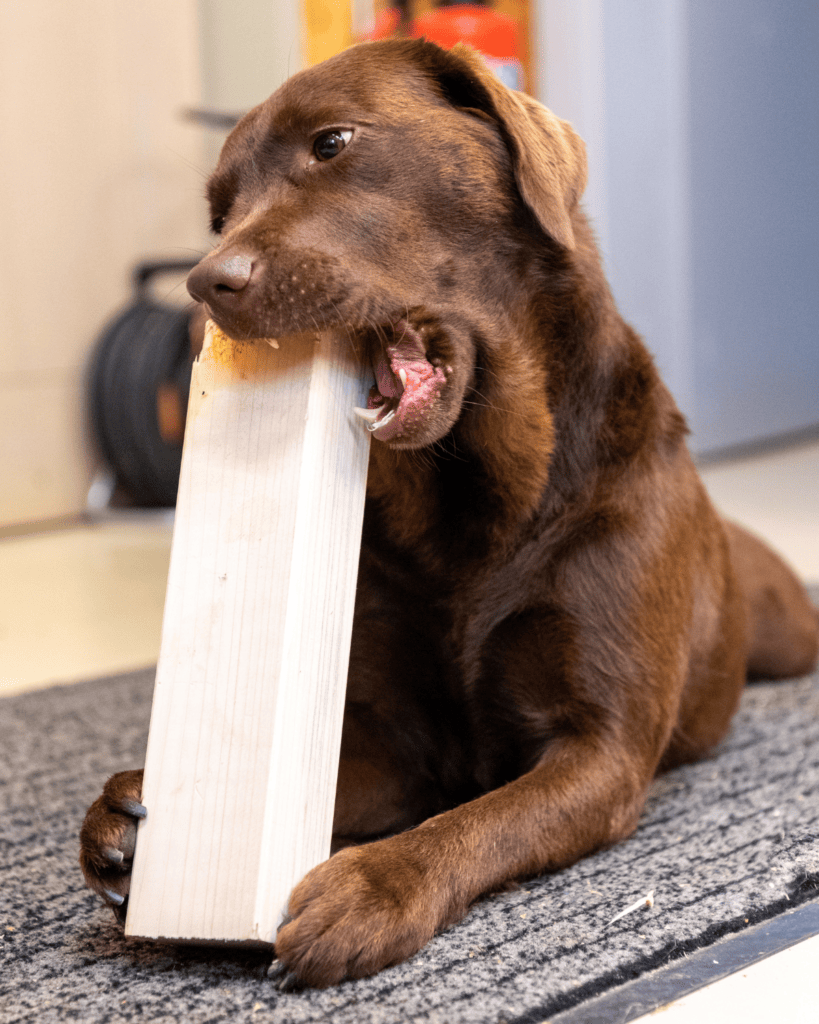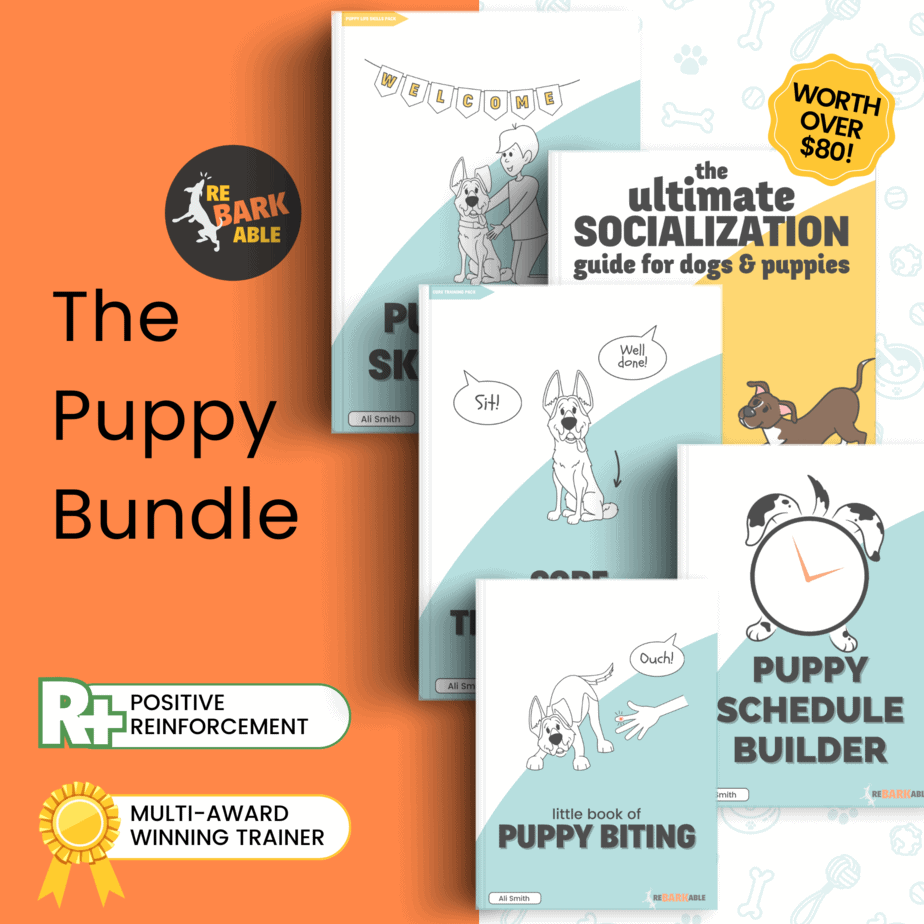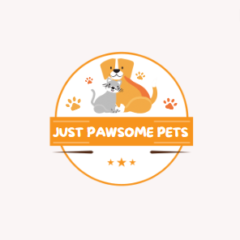Anti-Chew Sprays For Puppies: Why Professionals Don’t Recommend Them.
By admin / October 22, 2024 / No Comments / Small Animals
It’s a common product that gets recommended, but is there any value in bitter sprays as a deterrent to chewing?
If you’re here, you’re probably a new puppy parent (Congrats!) wondering whether bitter sprays will work to help you solve your chewing problem, right? Great! I’m glad to have found you (lovely when the internet does what it’s meant to, right?).
As a professional dog trainer, I see the frustration often “He chews everything! I even tried the anti-chew sprays and (insert issue from frustrated puppy parent here)”
Personally? I never advise my puppy parents to use them – and I know that’s the same for most other professional dog trainers.
So why is that? Let’s dive in and look at the reasons they’re not recommended, and what you can do instead!

How They’re Designed To Work
Bitter sprays are designed to be sprayed on an object or household items that puppy wants to chew, such as your furniture, or your sofa. Such that when your puppy tastes the item, they don’t enjoy the bitter taste and don’t want to taste it again. This, theoretically prevents them from chewing on anything with the spray deterrent.
However… This isn’t the best plan, and here’s why…
(Note: if you do choose to use bitter apple spray, please make sure it doesn’t use essential oils like tea tree oil, make sure it’s an alcohol-free formula, or propylene glycol to ensure you’re not accidentally giving your dog toxic things with your taste deterrents, focus on natural ingredients like lemon juice if you really have to.).
This is great for interacting with puppy who wants to play and wants to bite! It allows pup to really engage with you and is perfect for redirecting and even better? The bungee takes your pup’s yank out of it for your shoulders.
Edsel is a little pricey – but Edsel is the only toy that’s lasted 5 years in my home with 3 large dogs. I don’t let them sit and chomp on him like he’s a bone, but we do play tug and fetch all the time.
He’s the perfect intermediary for a puppy who’s learning what to bite if that puppy likes human skin.
This toy also doesn’t have an obnoxious squeaker! It’s got a squeaker with a much better tone.
5 Reasons Professionals Don’t Recommend Anti-Chew Sprays
1 – They don’t teach the right lesson.
Effectively, all a bitter apple spray or chewing deterrent teaches is “If it tastes yucky, don’t chew it”, not necessarily what to chew. So your table legs covered in bitter agents may work but your pup won’t really learn not to chew a table leg. Or, it can mean that when you stop using a spray the chewing starts over.
Not to mention that your puppy (like all dogs!) has a biological need to chew, especially when they’re teething, it’s why dog chews are such a big market.

2 – Its rarely effective
Whether your dog just licks off the dog “anti chew” sprays (yep, it happens!) or they just keep chewing through it, roughly 67% of dog parents find anti-chew sprays totally ineffective. The bittering agent is something some dogs actually enjoy, and can encourage chewing. Whilst it’s designed to be an unpleasant taste, it’s not always the case for all dogs! And many more dogs actually just don’t care, as our poll shows.

3 – It’s technically punishment
Believe it or not, when it comes to operant conditioning, bitter apple sprays or chew deterrents are actually classified as positive punishment (the application of an undesired sensation for an undesired behavior), I.e. your puppy creates a negative association with inappropriate items. And whilst this may seem like an effective way to communicate… it really isn’t quite as effective as you might think.
In the professional world, we’ve known for a long time that punishment is not needed in dog training!
4 – Puppies Explore With Their Mouth
It’s a pretty important socialization exercise, exploring the world, and to start creating that to become a punishing experience is kind of like if we started randomly electrifying things in a clothes store?
In one way, you’re meant to explore, but in another, you’re likely going to get worried that if you touch that sweater you love, it would become a concern you might get zapped… A slightly extreme example, but you get the idea.

5 – They Can Just Find A New Spot
If you don’t cover various surfaces that have a similar mouth feel, you may not have the best results, as dog owners will often miss a puppy’s desired areas, meaning puppy will just find themselves a spot that’s not the treated or affected area, that little inconspicuous area that you didn’t even think of.
What To Do Instead
So when we’re looking to move away from deterrent sprays, or we’re looking to avoid them entirely, what do we do?
Step 1 – Manage Access
To effectively train your puppy not to indulge in destructive chewing, it’s paramount to manage their access to surfaces and items they might be tempted to chew on. Begin by puppy-proofing your home; this involves removing items like shoes, children’s toys, and personal belongings from your puppy’s reach. It’s also crucial to secure loose wires and power cables from our furry friends to prevent them from becoming chew targets.
Providing a puppy-safe zone (like a play pen or crate) is another effective strategy, where you designate a specific area of your home that’s safe for your puppy to explore without getting into trouble.
These chews are really interesting, they last for ages, and dogs tend to love them.
We love these as a special treat, we don’t give them often, but they really do help relax dogs and bring them to a stage I call “Chew drunk”, because chewing releases endorphins for dogs and soothes them. So these are a wonderful choice.
(Warning, watch your pup the first few times, strong chewers or greedy guts can be tempted to chomp it into a few pieces and just swallow it down)
These are another single ingredient chew that’s bound to keep puppy focused and entertained. Whilst chews are never a replacement for a play session, this one comes close because of just how darn tasty they are!
These are root chunks from some heavy duty trees, and they crumble as opposed to splinter, so totally safe to ingest – which is awesome if you have a little pup who just can’t leave the wooden furniture alone.
Redirect puppy to this, and you’ll see puppy focus on the permitted chew, as opposed to the illegal chew, and it’ll give pup the texture they’re craving!
Step 2 – Redirect to appropriate chew toys
Then it’s supervision. Supervision and training play vital roles in this process. Keeping a close eye on your puppy allows you to intervene if they start showing interest in inappropriate objects.
The biggest and most important part of this is to select an appropriate thing to redirect to.
Such as, if your dog is chewing your wooden sideboard, redirecting pup to a nylabone? Isn’t really going to work. However, a chew root would be perfect. Appropriate toys and ideally natural chews with non-toxic ingredients is much more preferable to electrical cords!
The idea here is very much to match the texture as closely as possible. It’s much like if you’re craving chocolate cake, if someone tells you to eat a cucumber? It’s probably not going to do the same thing, and you’ll still want chocolate cake.
This part is allowing the chewing that puppy wants (so it’s inherently rewarding) and teaching them the appropriate things to chew. This way we’re ensuring pup is experiencing positive reinforcement.

Step 3 – Repeat & Be Patient
Next, keep going. Do it, do it again and again.
It’s not easy to keep up your patience, and I know the puppy phase demands so very much of it – but keep going and redirect. This is honestly the most important step, and it needs to be done slowly and consistently.
Step 4 – Give Freedom Slowly
As time goes by, you’ll give your pup more freedom. Which means you may not be monitoring them quite as much when they’re learning.
For this, much like with all of those teaching puppy to be confident alone and crate training, you start with small periods that they’re likely to get right, i.e. whilst you’re cooking perhaps! Or whilst you’re watching TV… So you’re present, but not paying attention 100%.
Then maybe build to more space, such as whilst you’re off in the bathroom, or whilst you pop to the store! It’s all about small steps and managing that exposure.

Q – What do I do if I My Puppy Starts Chewing Again?
Take it back a step or two, watch a little more and maybe find an interim step that can bridge the gap at which puppy didn’t succeed. Regression is totally normal and just a simple part of learning to live with a puppy!
Q – What About Teaching “Drop” or “Leave it”?
The problem with these cues is that they act after the fact. I.e. you have to let puppy do the wrong thing before you can give a new cue. So, truly, this is violating one of the core rules of dog training (truthfully, life…) a pinch of prevention is worth a pound of cure. You also then are exposing the pup to potential resource guarding issues and potentially consuming something unhealthy – and we always try to prevent potential risks, right? So focus on preventing rather than a remedy cue.
Q – The Chewing Only Happens When I’m Out Of The House Though?
We do have to take a little investigating to see if this is an anxious response to your not being home, this may be separation anxiety, it may just be that they’ve been given too much freedom too quickly.
But if you’re ever unsure, make sure to reach out to a professional trainer, separation anxiety specialist, behaviourist or vet behaviorist. (N.b. Not your regular practice vet!)
Remember, Humane Is Always The Best Approach!
Choosing a kind and positive approach to train puppies is definitely the way to go. It’s all about building that special bond of trust and understanding with your furry friend, which in turn makes training stick for the long haul.
Using rewards and praise helps puppies learn what behaviors you like, making them more eager to please and repeat those good actions. As opposed to dog chew deterrents that offer a “quick fix” for a new puppy owner. This foul-tasting spray is just not needed, and don’t believe the marketing! There is no such thing as effective anti-chew sprays!
Positive reinforcement, as a whole method, is super important for their mental and emotional health, steering clear of stress, discomfort, confusion and fear. It essentially guides them gently as they grow, helping them become confident, well-behaved dogs without the negative vibes that harsh training can bring. In a nutshell, keeping it positive not only makes training more enjoyable but also strengthens that adorable bond between you and your puppy.
If you need help avoiding chew deterrent spray, and want a trainer’s help? Get in touch! I have tonnes of ways to help.

Author, Ali Smith
Ali Smith is a professional, qualified, and multi-award winning trainer is the founder of rebarkable. She has always believed animals deserve kindness and champions force free methods. Believing that dog guardians will all choose the kindest options if proper information is provided, she aims to help all dog guardians who need it and make dog training as accessible as possible
Ali lives win Maryland, US with her husband and her three dogs.






